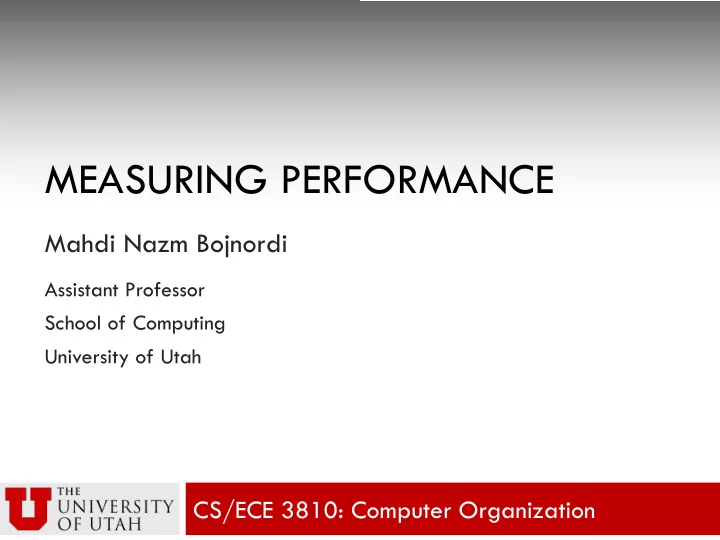

MEASURING PERFORMANCE Mahdi Nazm Bojnordi Assistant Professor School of Computing University of Utah CS/ECE 3810: Computer Organization
Overview ¨ Homework 1 will be posted tonight ¤ Deadline: Jan 17 th (midnight) ¨ This lecture ¤ Levels of program code ¤ Chips process ¤ Performance ¤ Design principles
Below Your Program ¨ Application software ¤ Written in high-level language ¨ System software ¤ Compiler: translates HLL code to machine code ¤ Operating System: service code n Handling input/output n Managing memory and storage n Scheduling tasks and sharing resources ¨ Hardware ¤ Processor, memory, I/O controllers
Levels of Program Code ¨ High-level language ¤ Level of abstraction closer to problem domain ¤ Provides for productivity and portability
Levels of Program Code ¨ High-level language ¤ Level of abstraction closer to problem domain ¤ Provides for productivity and portability ¨ Hardware representation ¤ Binary digits (bits) ¤ Encoded instructions and data
Levels of Program Code ¨ High-level language ¤ Level of abstraction closer to problem domain ¤ Provides for productivity and portability ¨ Hardware representation ¤ Binary digits (bits) ¤ Encoded instructions and data ¨ Hardware representation ¤ Binary digits (bits) ¤ Encoded instructions and data
Components of Computer ¨ Same components for all kinds of computer ¤ Desktop, server, embedded ¨ Input/output includes ¤ User-interface devices n Display, keyboard, mouse ¤ Storage devices n Hard disk, CD/DVD, flash ¤ Network adapters n For communicating with other computers
Inside Processor (CPU) ¨ Datapath ¤ performs operations on data ¨ Control ¤ sequences datapath, memory, ... ¨ Cache memory ¤ Small fast SRAM memory for immediate access to data
Inside Processor (CPU) ¨ AMD Barcelona: four processor cores
The Chip Manufacturing Process
Measuring Performance ¨ How to measure performance? ¤ Latency or response time n The time between start and completion of an event (e.g., milliseconds for disk access) ¤ Bandwidth or throughput n The total amount of work done in a given time (e.g., megabytes per second for disk transfer)
Measuring Performance ¨ How to measure performance? ¤ Latency or response time n The time between start and completion of an event (e.g., milliseconds for disk access) ¤ Bandwidth or throughput n The total amount of work done in a given time (e.g., megabytes per second for disk transfer) ¨ Which one is better? latency or throughput?
Measuring Performance ¨ Which one is better (faster)? Car Bus § Delay=10m § Delay=30m § Capacity=4p § Capacity=30p
Measuring Performance ¨ Which one is better (faster)? Car Bus § Delay=10m § Delay=30m § Capacity=4p § Capacity=30p § Throughput=0.4PPM § Throughput=1PPM It really depends on your needs (goals).
Measuring Execution Time ¨ Elapsed time ¤ Total response time, including all aspects ¤ Processing, I/O, OS overhead, idle time ¤ Determines system performance ¨ CPU time ¤ Time spent processing a given job ¤ Discounts I/O time, other jobs’ shares ¤ Comprises user CPU time and system CPU time ¤ Different programs are affected differently by CPU and system performance
Clocking and Cycle Time ¨ Operation of digital hardware governed by a constant- rate clock Clock period Clock (cycles) Data transfer and computation Update state
Clocking and Cycle Time ¨ Operation of digital hardware governed by a constant- rate clock Clock period Clock (cycles) Data transfer and computation Update state ¨ Clock period: duration of a clock cycle ¤ e.g., 250ps = 0.25ns = 250 � 10 –12 s ¨ Clock frequency (rate): cycles per second ¤ e.g., 4.0GHz = 4000MHz = 4.0 � 10 9 Hz
The Processor Performance ¨ Clock cycle time (CT = 1/clock frequency) ¤ Influenced by technology and pipeline ¨ Cycles per instruction (CPI) ¤ Influenced by architecture ¤ IPC may be used instead (IPC = 1/CPI) ¨ Instruction count (IC) ¤ Influenced by ISA and compiler ¨ CPU time = IC x CPI x CT ¨ Performance = 1/Execution Time
Speedup vs. Percentage ¨ Speedup = old execution time / new execution time ¨ Improvement = (new performance - old performance)/old performance ¨ My old and new computers run a particular program in 80 and 60 seconds; compute the followings ¤ speedup ¤ percentage increase in performance ¤ reduction in execution time
Speedup vs. Percentage ¨ Speedup = old execution time / new execution time ¨ Improvement = (new performance - old performance)/old performance ¨ My old and new computers run a particular program in 80 and 60 seconds; compute the followings ¤ speedup = 80/60 ¤ percentage increase in performance = 33% ¤ reduction in execution time = 20/80 = 25%
Principles of Computer Design ¨ Designing better computer systems requires better utilization of resources ¤ Parallelism n Multiple units for executing partial or complete tasks ¤ Principle of locality (temporal and spatial) n Reuse data and functional units ¤ Common Case n Use additional resources to improve the common case
Recommend
More recommend